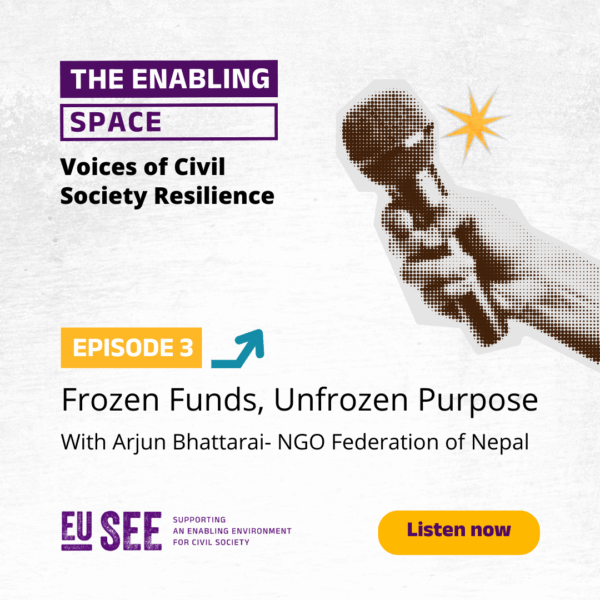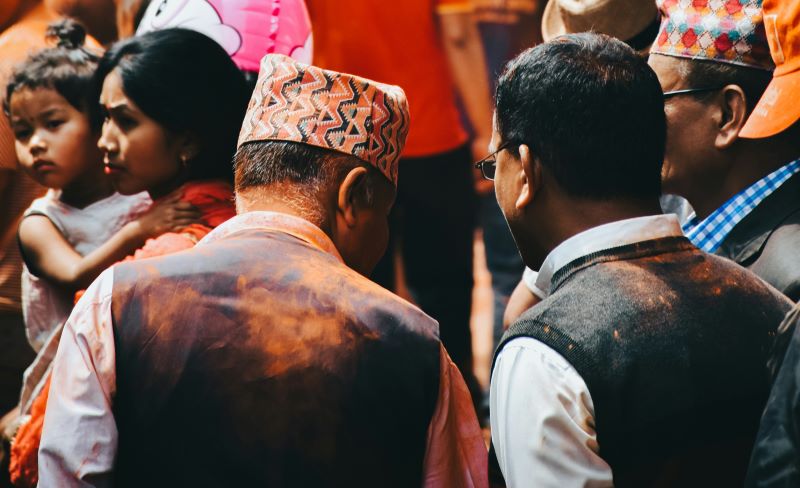By Bibbi Abruzzini and Clarisse Sih, Forus, EU SEE consortium partner
As the ripple effects of global aid squeeze and the USAID funding freeze continue to challenge civil society organizations worldwide, some networks are moving beyond crisis mode.
In a recent conversation on the Frozen Funds, Unfrozen Purpose podcast—part of the EU SEE consortium’s initiative—Forus’ Bibbi Abruzzini sat down with Arjun Bhattarai, President of the NGO Federation of Nepal (NFN), to unpack how Nepal’s civil society is confronting the shifting funding landscape while reinforcing homegrown resilience.
“Resilience must be homegrown,” said Arjun. “We can’t rely on the same models anymore. We are navigating these global shifts by rethinking how we organize, how we fund ourselves, and how we advocate.”
The warning signs are global, not isolated
Across the recent EU SEE alerts, the picture is clear: this is not just about Nepal—or even just about the USAID freeze. From Malaysia to Mexico, civil society is feeling the squeeze. The EU System for an Enabling Environment for Civil Society (EU SEE) is a global initiative working across 86 countries which through early warning alerts, monitoring, and flexible support, supports civil society actors, donors and governments understand the conditions that allow civil society to thrive—and what’s at stake when those conditions are under threat.
“In Malaysia, CSOs are struggling with frozen U.S. support,” Bibbi noted during the episode sharing some of the recent updates from civil society network members part of EU SEE. “In Indonesia, Dutch budget cuts and legal reforms are putting pressure on local NGOs. Meanwhile, in places like El Salvador and Nigeria, donor withdrawal has left a vacuum now filled with rising anti-CSO rhetoric.” These aren’t isolated incidents. They point to what Arjun described as “systemic fragility”—less support and less space for civil society action.
Civil society in Nepal: rethinking the model
NFN is taking proactive steps, for instance with a national civil society conference held in Kathmandu, where over 1,300 organizations gathered to assess the crisis—and start drawing a way forward. “We invited the Prime Minister, donor agencies, and civil society. We discussed the shrinking civic space, the funding crunch, and most importantly, we looked at solutions,” said Arjun.
Among those solutions, as mentioned by Arjun we find:
- Tapping into domestic philanthropy and crowdfunding
- Lobbying for transparent corporate social responsibility (CSR) policies
- Exploring social enterprise models
- Negotiating directly with the government for partnership policies and local funding support
“We are requesting our government to see civil society not just as temporary partners, but as essential contributors to society,” he said. “This means creating policies that ensure small NGOs and community organizations are part of CSR and public funding mechanisms.”
Nepal’s upcoming transition from a Least Developed Country (LDC) in 2026 also raises the stakes. Arjun emphasized that this shift demands a re-prioritization of both funding and focus—toward poverty eradication, climate resilience, youth employment, and women’s inclusion. One of the key messages from the conversation was around narrative power. “When donors pull out, it’s tempting for organizations to go quiet. But this is exactly when we must speak louder,” Bibbi said. “Governments and citizens need to see the value of civil society—not just in crises, but every day.”
In addition to financial strategies, NFN is also investing in storytelling, grassroots campaigns, and national mobilizations around democracy and rights. As Arjun shared: “We’re organizing and mobilizing people for Democracy Day. We’re talking about what an inclusive, participatory democracy really looks like. And we’re asking: how can civil society sustain itself even without donor support?”
Challenging the International Aid System
While NFN focuses on local solutions, Arjun also had a clear message for international donors. “Aid is not charity. It is a right,” he said. “Nepal is vulnerable to climate change, disasters, and poverty. Donors made commitments—like the 0.7% target—and they need to honor them.” He also pointed to the imbalance in current funding trends, where support often sidelines civil society. “We don’t want to be treated like subcontractors. We are partners. And it’s time for the donor community to rethink how they support democratic, citizen-driven development.”
NFN is also strengthening its own ecosystem by supporting its member organizations through capacity-strengthening: “We’re offering training on crowdfunding, proposal writing, new fundraising strategies—whatever our members need to become more self-reliant,” said Arjun. “We’re also collecting their problems, mentoring, and amplifying their voices.” These initiatives are part of NFN’s broader strategy to build sustainability and reduce dependence on international aid. “We must stand together—locally, regionally, and globally,” Arjun said. “ We need the support of international development partners, but we also need to be bold and proactive ourselves.”
The EU SEE consortium will soon host a webinar bringing together CSOs and donors from across Asia, Africa, and Latin America to continue this dialogue and build concrete solutions.
Until then, the message is clear: while funds may be frozen, purpose must remain unfrozen.

